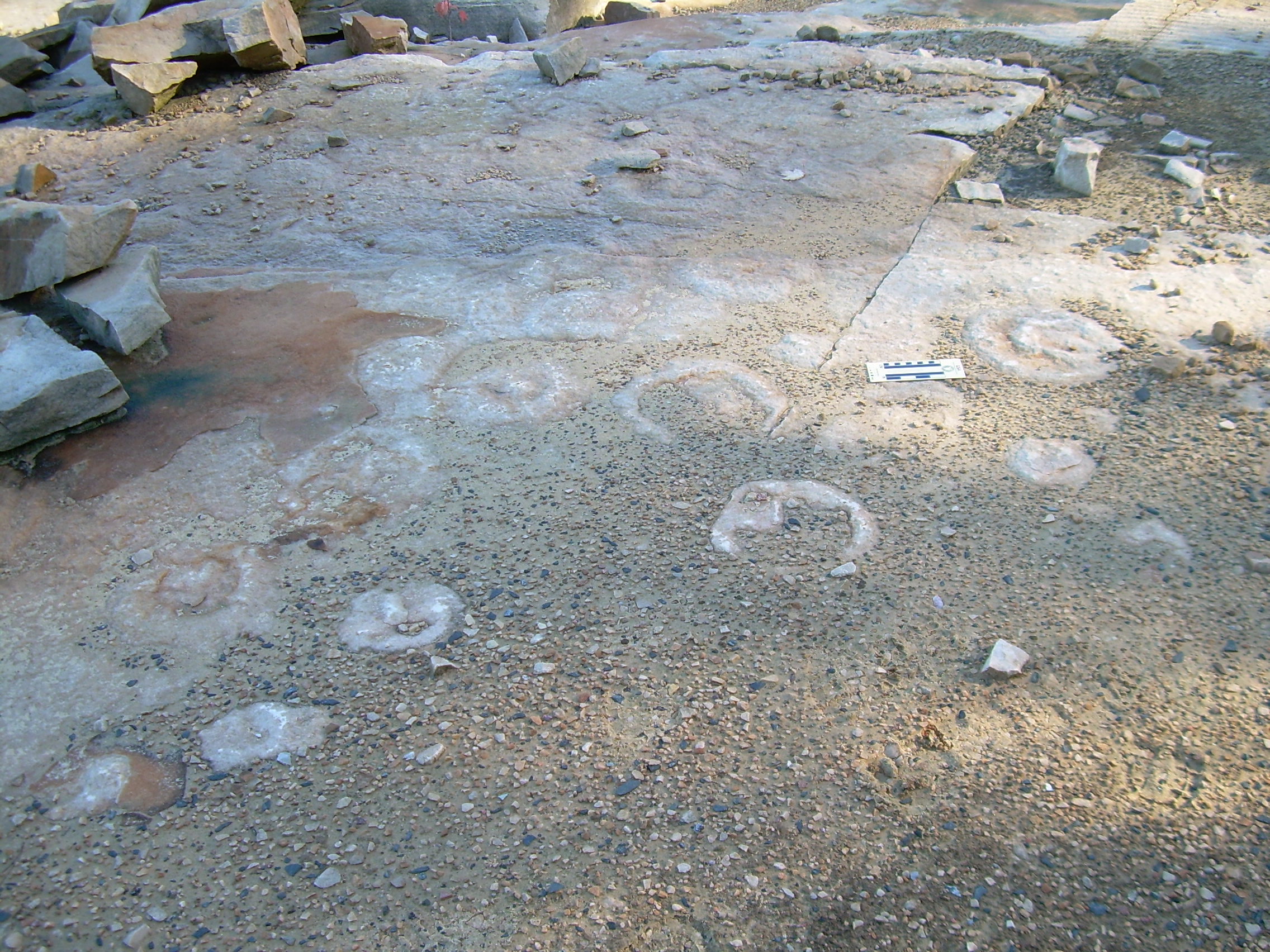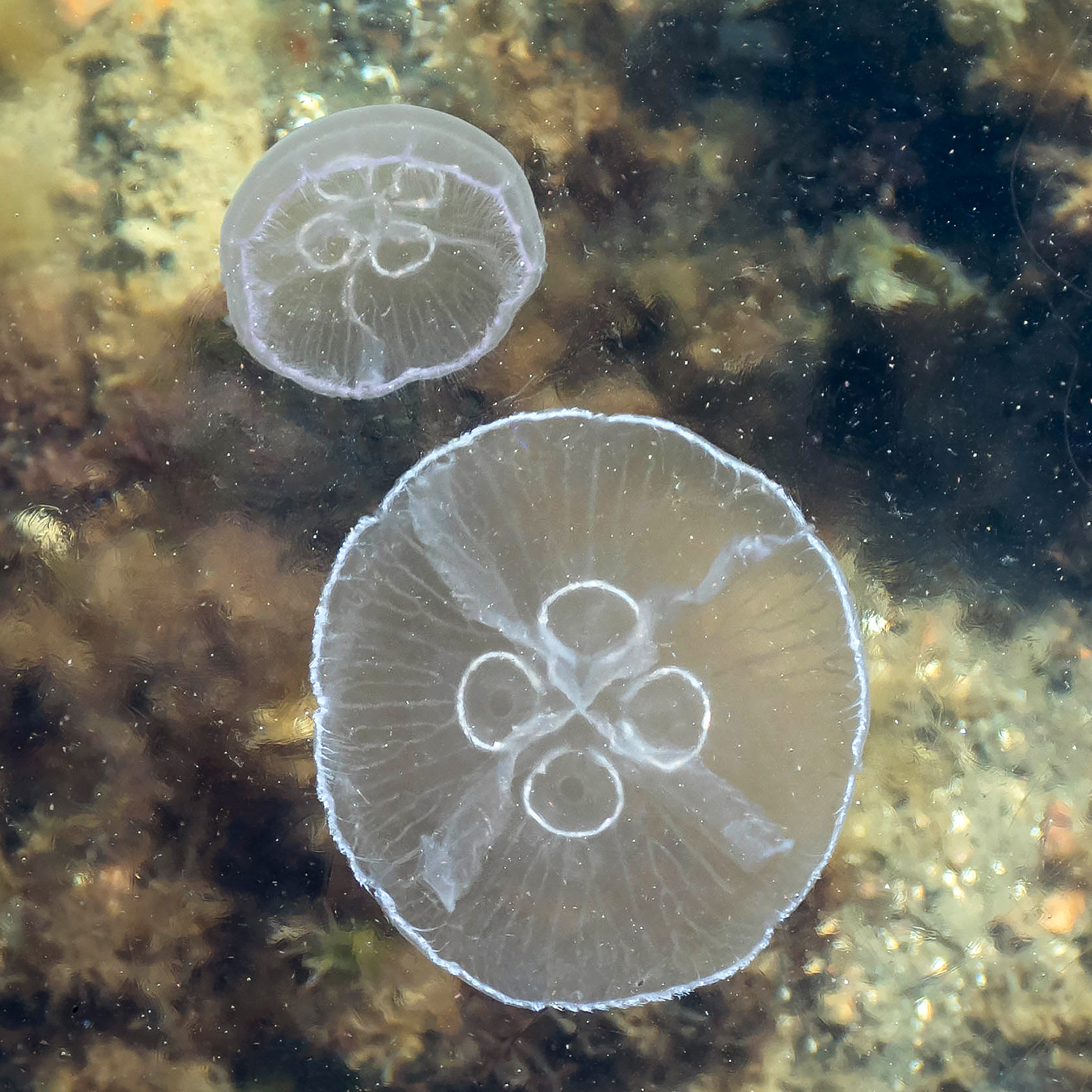|
Drymonema Gorgo
''Drymonema'' is a genus of true jellyfish, placed in its own family, the Drymonematidae. There are three species: ''Drymonema dalmatinum'', '' Drymonema gorgo'', and '' Drymonema larsoni'', which are found in the Gulf of Mexico, Atlantic Ocean and Mediterranean Sea. Classification ''Drymonema'' was described as a distinct family based on DNA evidence and morphological analysis, in 2011. The first species described, ''D. larsoni'', was named after the scientist Ronald G. Larson who pioneered work on the species in the 1980s. The new family Drymonematidae was the first new addition of true jellyfish (scyphozoans) described since 1921. Species *''Drymonema dalmatinum'' Haeckel, 1880 *'' Drymonema gorgo'' F. Müller, 1883 *'' Drymonema larsoni'' Bayha & Dawson, 2010 ''Drymonema larsoni'' "Pink Meanie" ''Drymonema larsoni'' is a species that forms large, dangerous blooms in the northern area of the Gulf of Mexico. ''Drymonema larsoni'' get their name "pink meanie" from their p ... [...More Info...] [...Related Items...] OR: [Wikipedia] [Google] [Baidu] |
Ernst Haeckel
Ernst Heinrich Philipp August Haeckel (; 16 February 1834 – 9 August 1919) was a German zoologist, naturalist, eugenicist, philosopher, physician, professor, marine biologist and artist. He discovered, described and named thousands of new species, mapped a genealogical tree relating all life forms and coined many terms in biology, including ''ecology'', '' phylum'', ''phylogeny'', and ''Protista.'' Haeckel promoted and popularised Charles Darwin's work in Germany and developed the influential but no longer widely held recapitulation theory ("ontogeny recapitulates phylogeny") claiming that an individual organism's biological development, or ontogeny, parallels and summarises its species' evolutionary development, or phylogeny. The published artwork of Haeckel includes over 100 detailed, multi-colour illustrations of animals and sea creatures, collected in his ''Kunstformen der Natur'' ("Art Forms of Nature"), a book which would go on to influence the Art Nouveau artistic mo ... [...More Info...] [...Related Items...] OR: [Wikipedia] [Google] [Baidu] |
True Jellyfish
The Scyphozoa are an exclusively marine class of the phylum Cnidaria, referred to as the true jellyfish (or "true jellies"). The class name Scyphozoa comes from the Greek word ''skyphos'' (), denoting a kind of drinking cup and alluding to the cup shape of the organism. Scyphozoans have existed from the earliest Cambrian to the present. Biology Most species of Scyphozoa have two life-history phases, including the planktonic medusa or polyp form, which is most evident in the warm summer months, and an inconspicuous, but longer-lived, bottom-dwelling polyp, which seasonally gives rise to new medusae. Most of the large, often colorful, and conspicuous jellyfish found in coastal waters throughout the world are Scyphozoa. They typically range from in diameter, but the largest species, ''Cyanea capillata'' can reach across. Scyphomedusae are found throughout the world's oceans, from the surface to great depths; no Scyphozoa occur in freshwater (or on land). As medusae, they eat a ... [...More Info...] [...Related Items...] OR: [Wikipedia] [Google] [Baidu] |
Drymonema Dalmatinum
''Drymonema'' is a genus of true jellyfish, placed in its own family, the Drymonematidae. There are three species: '' Drymonema dalmatinum'', '' Drymonema gorgo'', and '' Drymonema larsoni'', which are found in the Gulf of Mexico, Atlantic Ocean and Mediterranean Sea. Classification ''Drymonema'' was described as a distinct family based on DNA evidence and morphological analysis, in 2011. The first species described, ''D. larsoni'', was named after the scientist Ronald G. Larson who pioneered work on the species in the 1980s. The new family Drymonematidae was the first new addition of true jellyfish (scyphozoans) described since 1921. Species *'' Drymonema dalmatinum'' Haeckel, 1880 *'' Drymonema gorgo'' F. Müller, 1883 *'' Drymonema larsoni'' Bayha & Dawson, 2010 ''Drymonema larsoni'' "Pink Meanie" ''Drymonema larsoni'' is a species that forms large, dangerous blooms in the northern area of the Gulf of Mexico. ''Drymonema larsoni'' get their name "pink meanie" from their ... [...More Info...] [...Related Items...] OR: [Wikipedia] [Google] [Baidu] |
Drymonema Gorgo
''Drymonema'' is a genus of true jellyfish, placed in its own family, the Drymonematidae. There are three species: ''Drymonema dalmatinum'', '' Drymonema gorgo'', and '' Drymonema larsoni'', which are found in the Gulf of Mexico, Atlantic Ocean and Mediterranean Sea. Classification ''Drymonema'' was described as a distinct family based on DNA evidence and morphological analysis, in 2011. The first species described, ''D. larsoni'', was named after the scientist Ronald G. Larson who pioneered work on the species in the 1980s. The new family Drymonematidae was the first new addition of true jellyfish (scyphozoans) described since 1921. Species *''Drymonema dalmatinum'' Haeckel, 1880 *'' Drymonema gorgo'' F. Müller, 1883 *'' Drymonema larsoni'' Bayha & Dawson, 2010 ''Drymonema larsoni'' "Pink Meanie" ''Drymonema larsoni'' is a species that forms large, dangerous blooms in the northern area of the Gulf of Mexico. ''Drymonema larsoni'' get their name "pink meanie" from their p ... [...More Info...] [...Related Items...] OR: [Wikipedia] [Google] [Baidu] |
Drymonema Larsoni
''Drymonema larsoni'' (also known as the "pink meanie") is a species of jellyfish belonging to the class Scyphozoa The Scyphozoa are an exclusively marine class of the phylum Cnidaria, referred to as the true jellyfish (or "true jellies"). The class name Scyphozoa comes from the Greek word ''skyphos'' (), denoting a kind of drinking cup and alluding to the .... Following a mass sighting in 2000 in the Gulf of Mexico, the species and the rest of its genus were put in their own family, a new subset of the true jellyfish. References Drymonematidae Animals described in 2010 {{Scyphozoa-stub ... [...More Info...] [...Related Items...] OR: [Wikipedia] [Google] [Baidu] |
The Biological Bulletin
''The Biological Bulletin'' is a peer-reviewed scientific journal covering the field of biology. The journal was established in 1897 as the ''Zoological Bulletin'' by Charles Otis Whitman and William Morton Wheeler. In 1899 the title was changed to ''The Biological Bulletin'', and production was transferred to the Marine Biological Laboratory at Woods Hole, Massachusetts. The current editor-in-chief is Kenneth M. Halanych. ''The Biological Bulletin'' is indexed by several bibliographic services, including Index Medicus, MEDLINE, Chemical Abstracts, Current Contents, BIOBASE, and Geo Abstracts. Six issues are published per year and all content is made freely available one year after publication. According to the ''Journal Citation Reports ''Journal Citation Reports'' (''JCR'') is an annual publicationby Clarivate Analytics (previously the intellectual property of Thomson Reuters). It has been integrated with the Web of Science and is accessed from the Web of Science-Core Collec ... [...More Info...] [...Related Items...] OR: [Wikipedia] [Google] [Baidu] |
Ronald J
Ronald is a masculine given name derived from the Old Norse ''Rögnvaldr'', Hanks; Hardcastle; Hodges (2006) p. 234; Hanks; Hodges (2003) § Ronald. or possibly from Old English '' Regenweald''. In some cases ''Ronald'' is an Anglicised form of the Gaelic '' Raghnall'', a name likewise derived from ''Rögnvaldr''. The latter name is composed of the Old Norse elements ''regin'' ("advice", "decision") and ''valdr'' ("ruler"). ''Ronald'' was originally used in England and Scotland, where Scandinavian influences were once substantial, although now the name is common throughout the English-speaking world. A short form of ''Ronald'' is ''Ron''. Pet forms of ''Ronald'' include ''Roni'' and ''Ronnie''. ''Ronalda'' and ''Rhonda'' are feminine forms of ''Ronald''. '' Rhona'', a modern name apparently only dating back to the late nineteenth century, may have originated as a feminine form of ''Ronald''. Hanks; Hardcastle; Hodges (2006) pp. 230, 408; Hanks; Hodges (2003) § Rhona. The names ... [...More Info...] [...Related Items...] OR: [Wikipedia] [Google] [Baidu] |
Scyphozoa
The Scyphozoa are an exclusively marine class of the phylum Cnidaria, referred to as the true jellyfish (or "true jellies"). The class name Scyphozoa comes from the Greek word ''skyphos'' (), denoting a kind of drinking cup and alluding to the cup shape of the organism. Scyphozoans have existed from the earliest Cambrian to the present. Biology Most species of Scyphozoa have two life-history phases, including the planktonic medusa or polyp form, which is most evident in the warm summer months, and an inconspicuous, but longer-lived, bottom-dwelling polyp, which seasonally gives rise to new medusae. Most of the large, often colorful, and conspicuous jellyfish found in coastal waters throughout the world are Scyphozoa. They typically range from in diameter, but the largest species, ''Cyanea capillata'' can reach across. Scyphomedusae are found throughout the world's oceans, from the surface to great depths; no Scyphozoa occur in freshwater (or on land). As medusae, they eat a ... [...More Info...] [...Related Items...] OR: [Wikipedia] [Google] [Baidu] |
Aurelia (cnidarian)
''Aurelia'' is a genus of scyphozoan jellyfish, commonly called moon jellies. There are currently 25 accepted species and many that are still not formally described. The genus was first described in 1816 by Jean-Baptiste Lamarck in his book ''Histoire Naturelle des Animaux sans Vertèbres'' (Natural History of Invertebrates). It has been suggested that ''Aurelia'' is the best-studied group of gelatinous zooplankton, with ''Aurelia aurita'' the best-studied species in the genus; two other species, '' Aurelia labiata'' and '' Aurelia limbata'' were also traditionally investigated throughout the 20th century. In the early 2000s, studies that considered genetic data showed that diversity in ''Aurelia'' was higher than expected based solely on morphology, so one cannot confidently attribute the results from most of the previous studies to the species named. More recently, studies have highlighted the morphological variability (including the potential for phenotypic plasticity) in this ... [...More Info...] [...Related Items...] OR: [Wikipedia] [Google] [Baidu] |
Allometry
Allometry is the study of the relationship of body size to shape, anatomy, physiology and finally behaviour, first outlined by Otto Snell in 1892, by D'Arcy Thompson in 1917 in ''On Growth and Form'' and by Julian Huxley in 1932. Overview Allometry is a well-known study, particularly in statistical shape analysis for its theoretical developments, as well as in biology for practical applications to the differential growth rates of the parts of a living organism's body. One application is in the study of various insect species (e.g., Hercules beetles), where a small change in overall body size can lead to an enormous and disproportionate increase in the dimensions of appendages such as legs, antennae, or horns The relationship between the two measured quantities is often expressed as a power law equation (Allometric equation) which expresses a remarkable scale symmetry: : y = kx^a \,\! or in a logarithmic form: : \log y = a \log x + \log k\,\! or similarly \ln y = a \ln x ... [...More Info...] [...Related Items...] OR: [Wikipedia] [Google] [Baidu] |
Drymonematidae
''Drymonema'' is a genus of true jellyfish, placed in its own family, the Drymonematidae. There are three species: ''Drymonema dalmatinum'', ''Drymonema gorgo'', and ''Drymonema larsoni'', which are found in the Gulf of Mexico, Atlantic Ocean and Mediterranean Sea. Classification ''Drymonema'' was described as a distinct family based on DNA evidence and morphological analysis, in 2011. The first species described, ''D. larsoni'', was named after the scientist Ronald G. Larson who pioneered work on the species in the 1980s. The new family Drymonematidae was the first new addition of true jellyfish (scyphozoans) described since 1921. Species *''Drymonema dalmatinum'' Haeckel, 1880 *''Drymonema gorgo'' F. Müller, 1883 *''Drymonema larsoni'' Bayha & Dawson, 2010 ''Drymonema larsoni'' "Pink Meanie" ''Drymonema larsoni'' is a species that forms large, dangerous blooms in the northern area of the Gulf of Mexico. ''Drymonema larsoni'' get their name "pink meanie" from their preda ... [...More Info...] [...Related Items...] OR: [Wikipedia] [Google] [Baidu] |
Scyphozoan Genera
The Scyphozoa are an exclusively marine class of the phylum Cnidaria, referred to as the true jellyfish (or "true jellies"). The class name Scyphozoa comes from the Greek word ''skyphos'' (), denoting a kind of drinking cup and alluding to the cup shape of the organism. Scyphozoans have existed from the earliest Cambrian to the present. Biology Most species of Scyphozoa have two life-history phases, including the planktonic medusa or polyp form, which is most evident in the warm summer months, and an inconspicuous, but longer-lived, bottom-dwelling polyp, which seasonally gives rise to new medusae. Most of the large, often colorful, and conspicuous jellyfish found in coastal waters throughout the world are Scyphozoa. They typically range from in diameter, but the largest species, ''Cyanea capillata'' can reach across. Scyphomedusae are found throughout the world's oceans, from the surface to great depths; no Scyphozoa occur in freshwater (or on land). As medusae, they eat a ... [...More Info...] [...Related Items...] OR: [Wikipedia] [Google] [Baidu] |




